Chinese Algae Eater fish are a favorite of pet stores all over the world. When small they are fast, strange-looking fish with a big appetite for algae. And as adults they remain strange in appearance but less interested in algae.
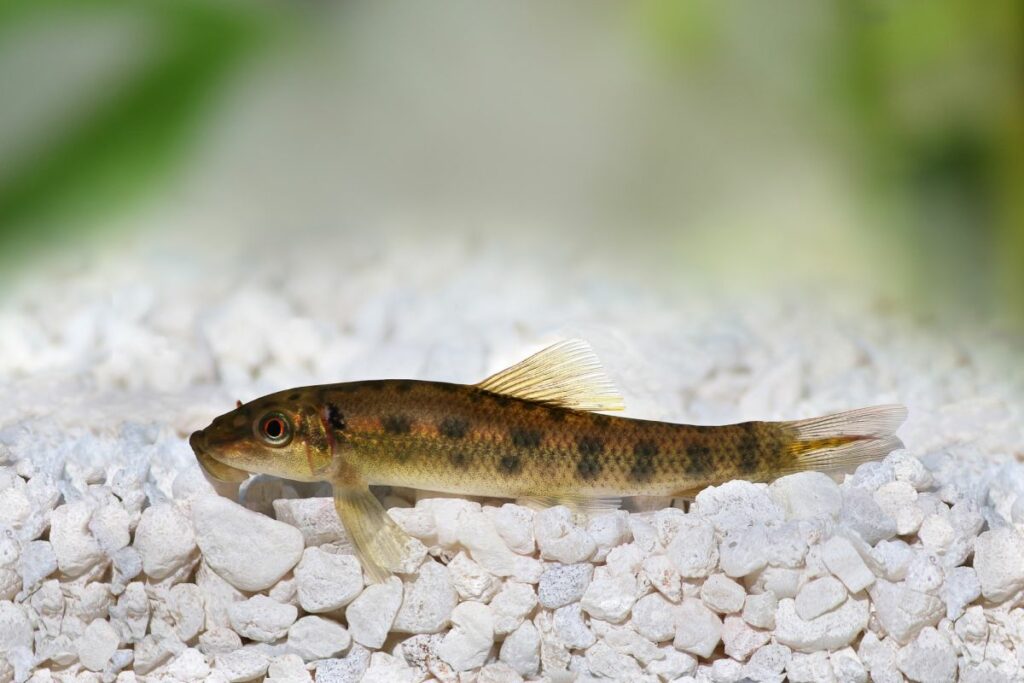
Still, their charming, downturned mouth and bulbous eyes makes them a pleasure to keep. China Algae Eaters are also one of the more long-lived aquarium fish and are easy to care for.
What is the Chinese Algae Eater?
With their downturned sucker mouth you might be reminded of a Pleco or Suckermouth Catfish. But the Chinese Algae Eater is not related to them at all. Plecostomus are from South America while these fish are found in Southeast Asia.
You will find wild Chinese Sucker fish not in China but Thailand, Laos, and Vietnam. Their sucker mouths allow them to stay in place in fast flowing streams and rivers. But the fish will enter still water looking for patches of algae and biofilm. Flooded rice paddies are a favorite grazing ground of theirs.
Almost every pet store in the country has the Asian Algae Eater in stock. Yet as common as they are not every aquarist realizes what they are getting into with one. As babies they are quite cute and are eager, active algae eaters.
But the larger a Chinese Algae Eater gets the meaner and more territorial it becomes. They also become less interested in algae, preferring soft plants, fish flakes, and other diverse food sources.
They may even take a liking to the mucus of tank mates, which can even kill them if it happens too often. Chinese Algae Eaters are very easy to keep. But consider for a while before buying one as rehoming an aggressive adult is difficult to do.
Common Names: Chinese Algae Eater, Chinese Sucker Fish, Asian Algae Eater, Golden Algae Eater, Albino Algae Eater
- Scientific Name: Gyrinocheilus aymonieri
- Origin: Southeast Asia
- Length: 6 to 10 inches
- Aquarium Size: 30 gallons
- Temperament: Semi-Aggressive
- Ease of Care: Very Easy
Color Varieties of Chinese Algae Eater
The wild type Chinese Algae Eater is unusual in terms of its body plan. But it’s not a very colorful fish. They are muddy green or brown with dark spots, which help them blend into river and lake beds. There are a few captive raised varieties that have more brilliant colors, however.
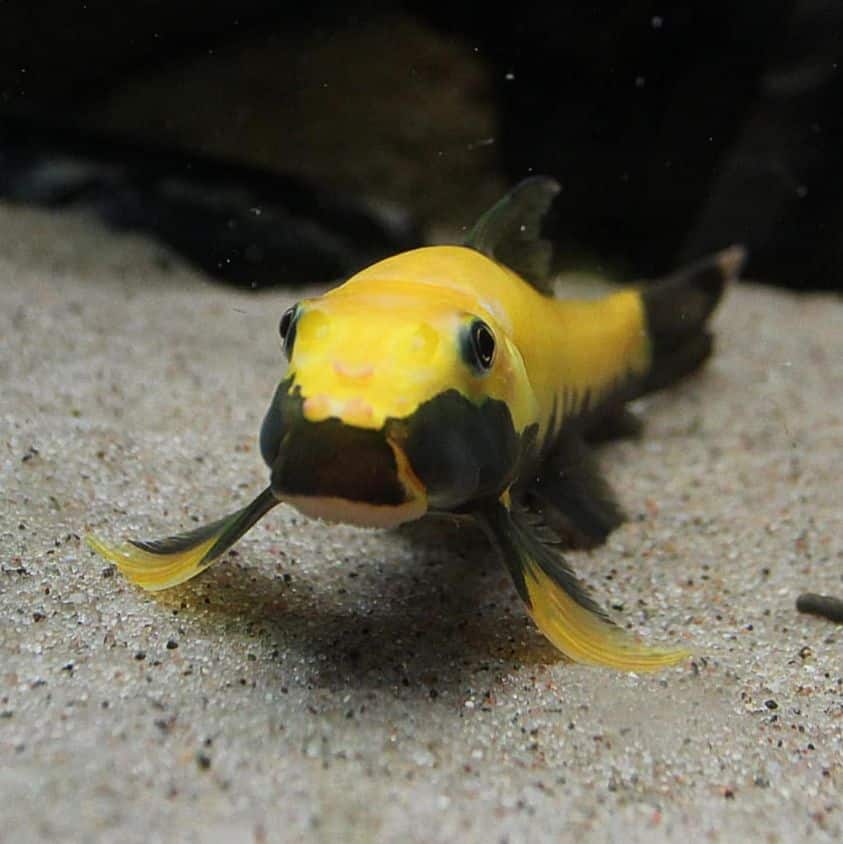
The most popular is the Golden Algae Eater. Rather than a drab green these fish are a light yellow or pale gold color. Best of all, they keep their yellow tones even when full grown. The Albino Algae Eater fish is the other captive-bred color morph.
As you’d expect, the albinos are a milky white color with yellow eyes. Both the albino and Golden Algae Eaters have the same care requirements as the standard Chinese Algae Eater and grow just as large.
Chinese Algae Eater Care
Chinese Algae Eater care is not at all complicated. These fish are hardy, long-lived and accept a wide range of water conditions. The real challenge is choosing the right tank mates for one.
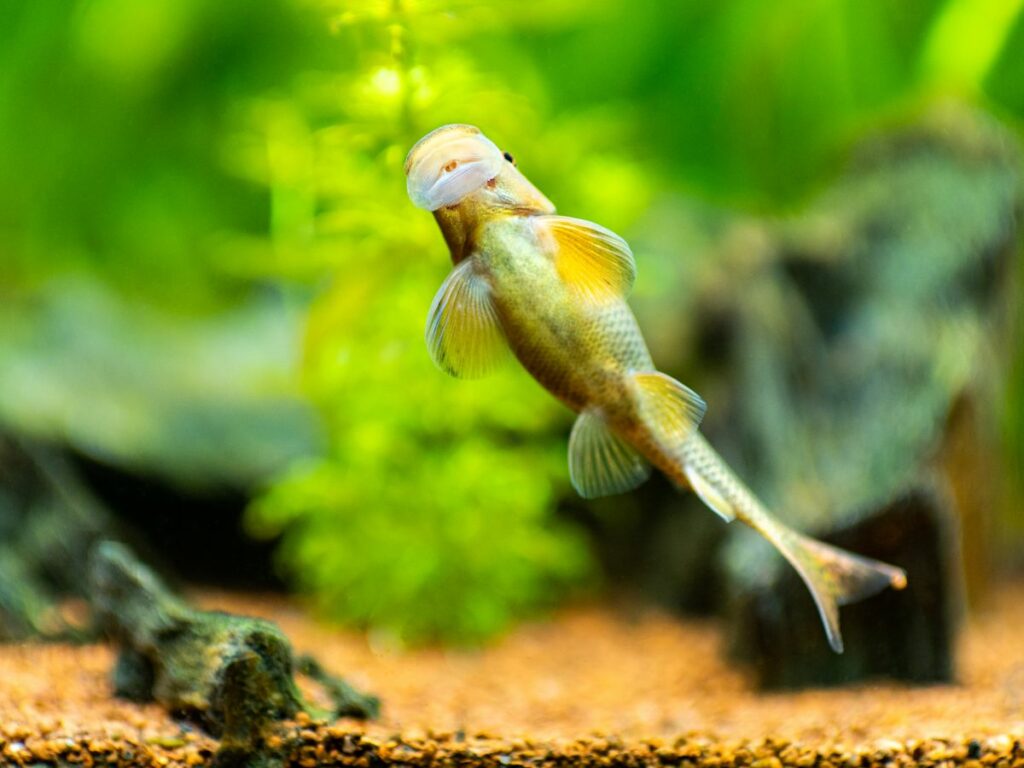
Chinese Algae Eater Tank Size
When you see a tank full of little Chinese Algea Eaters you might think these fish stay small. At around 2 to 3 inches and whip-thin, they look like the ideal addition to your first 10 gallon aquarium.
But a full grown Chinese Algae Eater fish is a different story. These fish grow to be anywhere from 6 to 10 inches long as adults. They are also quite active and need an aquarium at least 20 gallons in volume. 30 gallons is better if your fish is on the larger side. Smaller tanks will also increase your Chinese Sucker FIsh’s aggression towards its tank mates.
Plants and Decorations
Since they do eat algae, Chinese Algae Eaters are great additions to planted aquascapes. But it is best to just add them when they are young. The larger your Chinese Sucker fish get the rougher they tend to be on plants. Not only do they chew harder but they will even eat softer plant leaves when hungry.
These fish tend to be so active that they sometimes plow right through plants trying to get somewhere. If you have delicate carpeting plants or stem plants that aren’t established a Chinese Algae Eater may disturb them on a regular basis.
Water Conditions for Chinese Algae Eaters
Like the best aquarium fish for beginners the Chinese Algae Eater is quite unpicky when it comes to water conditions. It is hardy and versatile, finding a place in any aquarium. The water chemistry should be acidic or alkaline (pH 6.0 to 8.0) with no issues. But the closer you can get to neutral the more your algae eaters will appreciate it.
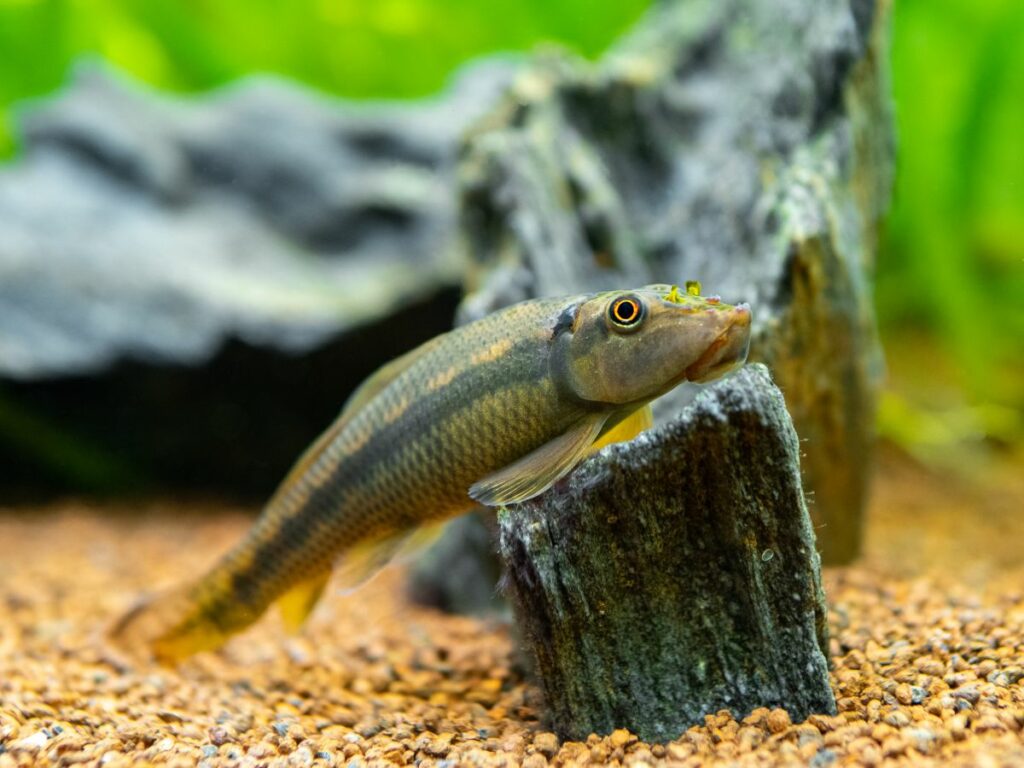
Chinese Algae Eaters do need tropical water temperatures, however. Sometimes you see them in goldfish aquariums as tank mates. These fish are tolerant of cool temperatures but become disease prone and lose their appetites if the temperatures stay cold for long.
As natives from Southeast Asia they prefer temperatures of 72-82°F. Any colder and you may see ich, body fungus, fin rot, and other diseases take hold.
What Do Chinese Algae Eaters Eat?
As you might guess, Chinese Sucker fish eat a lot of algae. They prefer green algae and won’t do much to reduce brown algae, green spot algae, or other forms of freshwater algae growth. Biofilm, the slimy coating of microorganisms that grow on aquarium surfaces, is also a favorite of theirs.
As they grow older they become less interested in algae and feed more on soft plants, worms, and other invertebrates they find. Even small shrimp and snails are on the menu for them.
Since they are truly omnivorous fish you should offer a Chinese Algae Eater extra protein. Fish flakes and sinking wafers for their tank mates will be eaten with gusto. Frozen foods like brine shrimp and tubifex worms also offer extra protein and fat.
Chinese Algae Eater vs Siamese Algae Eater
Siamese Algae Eaters have a similar name to the Chinese Algae Eater and are also from Southeast Asia and Thailand (Siam). But the similarities end right there.
Siamese Algae Eaters are very different fish that spend more time swimming in the midwater regions of the aquarium. They are gentler on plant leaves, very peaceful ,and don’t chew on their tank mates for their slime coats.
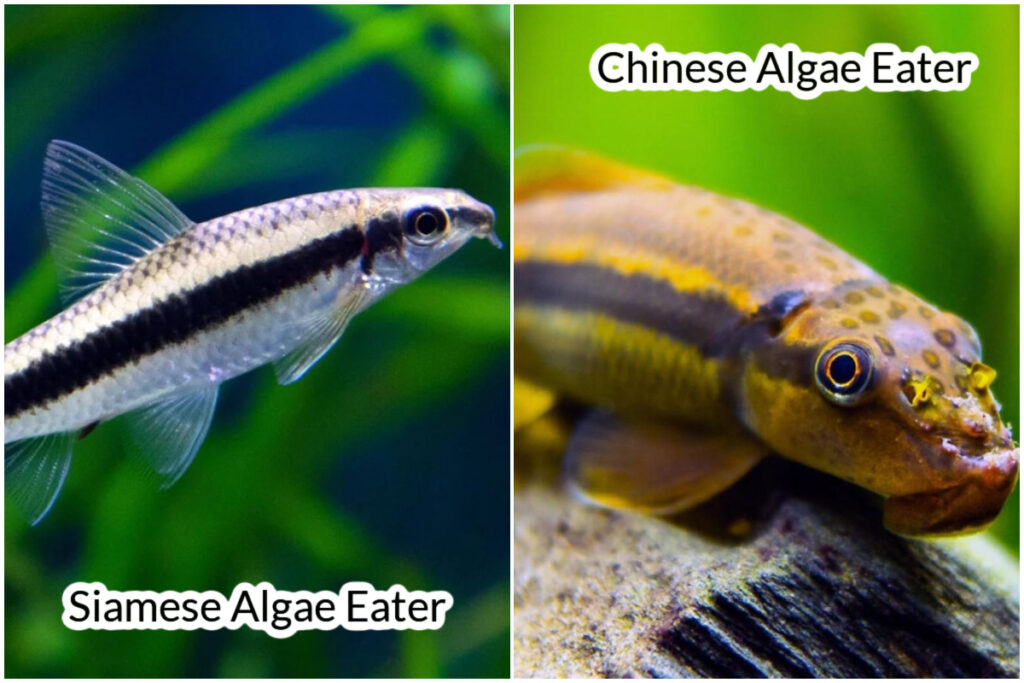
I would recommend a Siamese Algae Eater for most aquariums. To be honest, most species of algae eating fish are better choices than the Chinese Algae Eater. Dwarf Otocinclus stay small and are peaceful, schooling fish. Plecostomus are large but less aggressive.
Siamese Algae Eaters will also eat algae types that Chinese Algae Eaters won’t touch. Even staghorn and black beard algae, which are noxious to most fish, are on the menu.
Chinese Algae Eater Tank Mates
Choosing tank mates for the Asian Algae Eater gets difficult as the fish grow larger. When young they are peaceful, even shy aquarium fish that keep to themselves. But the older they get the more confident and bullying they become.
They are semi-aggressive fish and will push aside any tank mates that try to investigate their favorite hiding places. Worse, a full grown Golden Algae Eater often takes a liking to the skin mucus of slow moving tank mates like Goldfish or Angelfish. Fish mucus is a protein-rich protective barrier against disease causing organisms. It also streamlines them further so they glide through the water. Losing this mucus is dangerous and stressful if it happens a lot.
You will have success keeping them in community tanks with peaceful fish when young. But adult Chinese Algae Eaters should be kept with other large, semi-aggressive fish that will fight back if harassed.
Large Gouramis, large Barbs, Plecostomus, and Cichlids like Jack Dempsies and Red Devils are good tank mates for them. While aggressive, none of these cichlids are large enough to just eat a Chinese Algae Eater.
Breeding Chinese Algae Eaters
As common as these fish are, you’ll be surprised to learn that breeding the Chinese Algae Eater in home aquariums almost never happens. Why they don’t breed in home fish tanks is not known. They may be migratory in the wild. Or they may respond to seasonal cues.
All of the Chinese Algae Eating fish in pet stores come from massive fish farms in Asia. These fish are treated with hormones so they swell with eggs and breed on demand. When they do breed the female will lay as many as 3,000 eggs at a time.
Conclusion
While they are temperamental and pushy as adults, a young Chinese Algae Eater is a good addition to most community tanks. They do enjoy eating green algae so if you have too much overgrowth these fish will help tame it for you.
Just make sure you have enough space (or plans to upgrade fish tanks) as your Asian Algae Eater grows up.
More Frequently Asked Questions About Chinese Algae Eaters
Chinese Algae Eaters are a favorite fish for aquarists to keep. And here are a few of the most frequently asked questions I get about them.
Chinese Algae Eaters in most pet stores are very young fish about 1 to 2 inches long. But a full grown Chinese Algae Eater will reach anywhere from 6 to 10 inches in length. You will want at least 30 gallons of space for an adult fish.
The China Algae Eater is a semi-aggressive fish. They are territorial towards peaceful aquarium fish species that won’t fight back. They will also rasp mucus from the slime coats of broad sided fish for food.
The Chinese Algae Eater lifespan is generous for an aquarium fish. 7 to 10 years is normal for these algae eating fish.

